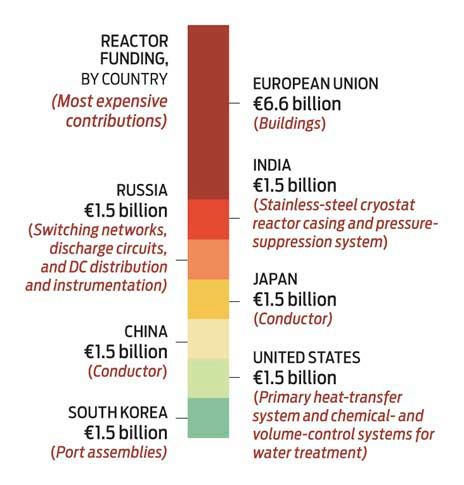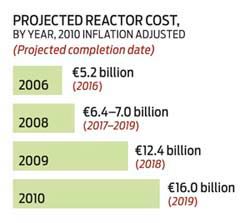You should watch some of his other videos. He does a lot of videos on futurism/sci-fi/cosmology/astrophysics. The Dyson sphere one is actually part of a series.
Some of his videos are just thought experiments, others are routed in physical. Sometimes he just spends a video debunking wild theories.
-
2019-03-15, 03:34 AM #201

Resident Cosplay Progressive
-
2019-03-15, 04:07 AM #202
-
2019-03-15, 04:39 AM #203
Some of you folks need to stop focusing on bad technology like Dyson Spheres and stunningly premature and for now unnecessary technology like Fusion reactors, and focus on technology, engineering and science that is grounded in the real world of the now or new now... not 200, 400, or 4000 years from now.
For example, the 2020 NASA Budget funds initial development of electric propulsion for a Mars Transit Vehicle. That is, in other words, a larger Ion Drive than the models that have flown already. This time paired with a small nuclear reactor or radioisotope-supported Stirling Engine.
That's something that could be flight tested by 2027, and scaled up to fly to Mars by 2034. And it's a hell of a lot more meaningful than speculating on Dyson Spheres that don't exist (the ESA's Gaia looked at 1.7 billion stars and found none).
-
2019-03-15, 05:08 AM #204
Just to confirm, are Dyson Spheres bad technology in your opinion purely because they don't exist? Because that's a ridiculous notion. The only other alternative is to use hydrogen-based planets to fuel Nuclear Fusion so you can produce close to the energy output of a star and that's a really limited method because you'll need to find many hydrogen-based planets to do exactly that. And ESA looking at 1.7 billion stars makes no difference because Dyson Spheres completely encapsulate the star and hides it from plain view, so they'd never even know they were there in the first place.
It also can't hurt to theorize about the future either.
-
2019-03-15, 09:47 AM #205
I'm not sure how nuclear fusion would be unnecessary given our almost universal aspirations to find an efficient clean energy source. Especially given that we can already generate fusion energy for short periods of time, something that realistically would not take 200-400 years to solve, more like 20-50.
Last edited by Techno-Druid; 2019-03-15 at 09:50 AM.
-
2019-03-15, 09:51 AM #206
-
2019-03-15, 10:01 AM #207
Last edited by Techno-Druid; 2019-03-15 at 12:04 PM.
-
2019-03-15, 11:39 AM #208
I think it's a major milestone for the US and SpaceX. Finally, that Russian piece of junk called Souze won't take astronauts to space. I the most important American government won't pay them. This also means that humankind can now create colonies on the Moon.
-
2019-03-15, 02:37 PM #209
Fusion's been 20 years away, for 50 years.
This is why I make that statment on Fusion. There's multiple angles to it.
First, a commercial fusion reactor that cost twice as much, as much, or half as much as the Large Hadron Collider, isn't a solution for anything, no matter its energy output. A Megaproject on that scale is too expensive to build more than one or two of, and the world would need way, way more than one or two. The upper limit of what commercial large scale but sub-Mega project costs is roughly a few billion dollars for construction. Fission Power plants are at or just above that (and thus need government help). Fusion would be well beyond that.
A $25 billion Fusion reactor is simply uneconomical to a series of $800 million LNG plants, $600 million Solar or Wind farms or cheaper Fission plants that all together have a higher net energy output.
Secondly, centralizing power production, as you often see in fiction, with a single large reactor, is fundamentally dangerous, inefficient and the world is moving in the opposite direction for litterally everything else. If you could build a single reactor that would provide power to the entirety of the United States, you'd also be introducing a single point of failure. What happens when it needs to be shut down for maintence? What happens if there is a catastrophic failure? What happens if someone flies a plane into it? The closest we have to this analog is in the North East with small states and one or two historic Nuclear Fission reactors providing a large share of the power needs to those states. The dangers raises is fundamentally the same. Even in a controlled sense. When Vermont began the process of decomissioning its only Nuclear Power plant that it was dependent on (think of it as a scale model of the US in this sense), they had to scramble to find alternative energy from elsewhere.
Making everything distributed is more fault-tolerant and saver. That way when when one part fails, the other parts keep going. The kind of Fusion Reactors that would make sense would be small scale, about $500 million, and powering the needs of a sixth a State, for a total of 250 nation wide. That way when one needs to be shut down, or fails, it isn't a national emergency. Or even if we generalized our model and said the US would be powered by 3 fusion reactors and not one, the same principle holds true. Fission reactors work in the US now because (A) it's only about 20% of the total, (B) there are about 100 of them and (C) there are many non-nuclear redundancies.
Thirdly, and this hooks up to the first two above, the most logical direction to combine economics of plant building plus distribution is Solar and LNG. And if there must be a nuclear angle, a "nuclear battery" fission reactor design, which can be built with existing engineering and materials, is still a better choice than a fusion reactor megaproject or a fusion reactor battery.
Fourthly the issue of "clean" is more political than technological. Fission reactors are extremely clean compared to the alternatives. It does produce long lived nuclear waste though (unlike Fusion reactors). It's a big planet. We can put it all in one spot and lock it up until the end of time, and that one spot could hold literally all of it. The fact that we don't is, again, political.
Fifthly, required energy densities in the real world are different than what they are in fiction. While the rest of the world will have increasing energy needs, they are mostly already meeting that through Coal, LNG, Solar and Nuclear. Two of those four are clean, one is cleaner and the first, coal, is dirty. For the united States, our energy requirement growth has flatlined. Increasing efficiency is seeing to that and there is no reason to think that won't be the case in the future. Since the most developed country in the word's actual energy needs, while considerable, are not requiring cosmic-level solutions, the more economical and reasonable approach is to answer those needs with things we have now - LNG, Wind and Solar - and prepare new technologies that we know we can make if we invest in them, like simplified, safer, cheaper nuclear fission. From this angle, Fusion Reactors are kind of the answer to a question nobody asked.
Don't get me wrong. The world should absolutely work on fusion... as a science project. ITER is perfectly fine. And maybe, maybe, in the far distant future it will lead to an economic reactor. But it isn't anything we should be spending more than a few hundred million dollars a year on, when more economic, scalable and near term solutions are already here.
-
2019-03-15, 02:39 PM #210
-
2019-03-15, 02:56 PM #211
Yeah but... That was when it wasnt even possible. Now we actually know the science works and we are able to create and sustain it. Thats a huge difference.
- - - Updated - - -
That cost is in RND. That isnt the physical cost of building the reactors, consodering we have multiple reactors being developed around the world that arent all costing 25 billion dollars.
The projected costs of commercial reactors arent unreasonable ITER isnt a commercial reactor.
-
2019-03-15, 02:56 PM #212
Dyson Spheres are technology so far beyond us it isn't worth speculating about in either terms of "futurism" or in a thread about real space, which this is. There is no practical rationale as to building them now, or for any reason that is realistic. The energy isn't needed. The surface area isn't needed. Speculation to them purely lies in the realm of "I think they are cool", not "It will exist for a purpose and this is it". If our population and energy needs grew to the scale where we needed to construct such a thing, then that would be different. But there is no reason to think we ever will. In fact the good bet is our population gets a fair bit smaller in coming centuries, not larger.
Secondly there is an ethical dimension to it, that directly hooks into more realistic colonization of planets in our own solar system. Mars, the Moon and what not are effectively pristine now. Unchanged on the time scale of tens of millions or billions of years (in the case of some moons) except for asteroid impacts. Random places on Mars, for example, give probes access to rocks older than the oldest ones on Earth. The lack of Earth-like weather, surface oceans and active plate tectonics will do that.
The second we start building infrastructure on these planets, these "New Edens" will also be spoiled. We will disrupt that which has been unchanged, in many cases, since the first Trees evolved on earth. And it will be impossible to undo. There is precedent to this. When North America was first colonized in the 16th, 17th and 18th centuries, vast Old Growth Primary Forests covered the East coast. Think the analog of the depths of the Amazon, where only natural processes were at work. Almost all of it was razed by the 1920s. The forests you see in the Eastern US now are largely Secondary forest, that grew after colonization, on top of where millennia old forests once stood.
Do we have a right to do this everywhere in the Solar system? Is it ethical? And to the larger point of a Dyson sphere, is it ethical to destroy entire planets to consume their natural resources to build one? That would mean a lot more than just disrupting a section of Mars. It would mean no more Mars.
The human race doesn't yet have the experience, the understanding, or the need to answer a question at that scale now... and it's one that is fundamental to the entire Dyson sphere thought experiment. Even "Colonization of Mars" is more hypothetical, because the most we're going to do on Mars in the 21st century is on the scale of the US's South Pole Research Laboratory that hosts a 45-150 people.

If we have a 150 people on Mars in a thing like that by 2100, it'll be a triumph. But that still falls well short of needing to answer the ethical question put forward regarding disruption of Mars natural state. The solution at hand would be replicating the Antarctic approach, which would be to minimize the impact.
Lastly the ESA looking at 1.7 billion stars is definitive, because even a Dyson Sphere would emit infrared and loner wavelengths. Gaia looked at infrared. It found nothing. If there was a Dyson sphere around those 1.7 billion stars, it would have found it.
https://medium.com/starts-with-a-ban...y-447f5f87c2dc
-
2019-03-15, 02:57 PM #213
I think most people should logically be on the "build more nuclear power plants" train.
To play devil's advocate, our primary reason for minimizing out impact on Antarctica is to not disrupt the ecosystem of the continent. That's primarily the reason why non-native, non-human animals like sled dogs and horses are no longer permitted to be transported there. Originally Posted by Skroe
Originally Posted by Skroe
With Mars and much of the Inner Solar System, this becomes a non-issue as we are approaching colonization with the idea of long-term settlement in the long run, be through paraterraforming or terraforming (however feasible). The 'goal' outlined by most who support colonization is for humans to become a multiplanetary species.
Antarctica offers very little existential value, at least now. The prevailing belief of those who do support a "multiplanetary species mindset" is to ultimately have a "back up" population of humans in the event of a mass extinction event on Earth or a similar situation as dire.Last edited by Techno-Druid; 2019-03-15 at 03:16 PM.
-
2019-03-15, 03:26 PM #214
The cost for a reactor is absolutely in construction costs. And the only actual energy-producing reactor, rather than physics experiment, being built right now, is ITER. One. Not "multiple". One. The Tokamak's at universities around the world are not the same thing. Wendelstein 7-X and the like are science experiments.
https://spectrum.ieee.org/energy/nuc...on-is-not-free
I'll say again, you folks want Fusion because you've seen it in Science Fiction and you think it is cool and it will save things, not because of its practicality or its realistic potential at this juncture. It is basically technology idolatry.
Your position would be logical if ITER had been built and running and shown the way forward towards economic commercial fusion in the form of DEMO (which will be larger still). Then you can rationally argue the need to take the next logical step. But as it stands right now, when the world hasn't even once produced break even fusion (and not for lack of trying either) to want to dive into head first into speculating as to the widespread uses of this technology t is irrational. It's basically appealing to magic, saying magic and your faith in the magic will fix things that don't presently work, but should. That's religion. It has no place in science and technology.
I stand by my comments in full. Fund ITER. Keep chipping away at fusion. But count on Solar, Fission, Wind and LNG to be the principal energy sources for the world this century and spend more to improve those technologies. And frankly Solar+Batteries may be the best of all of them.
- - - Updated - - -
I used to be. Then the economics of Nuclear never got better despite 15 years of trying. Meanwhile Solar is almost following its mini-Moore's Law, and more important, have exploited economy of scale in a way nuclear never will in its present state.
It's very possible Solar is just the superior technology that came along and is killing off the worse ones, nuclear included.
This is even true of space missions. Galileo to Jupiter in the 1990s used a Radioisotope thermal electric generator, but JUNO, in orbit around Jupiter now, uses Solar. Cassini around Saturn also used RTGs, but the next probe is likely to be solar as well. The Europa Clipper probe to Europa, flying in 2023, is Solar.
Hell, while the Ion Drive on the Mars Transit Vehicle we'll build to send a crew there is currently planned to be powered by a small fission reactor, there is a very good chance that, it too, will be solar instead.
- - - Updated - - -
While I agree with the goal in principle and have spoken to that effect countless times, what I was conveying with my comparison, is that, realistically, any Mars base and any Lunar base we have this century and into the early portion of next one, will be largely limited to government employees and maybe contractors engaging in scientific research. It's going to be pretty modest, like the South Pole base which is a much grander replacement of the older one from the 1970s. What it is not going to be is actual "colonization"... sending people there to live and build infrastructure and lives and industries, until the middle part of the 22nd century at my reckoning.
That may seem like a long timescale, but it's pretty consistent with the colonization of the Americas. The Spanish and Portuguese spent the early 16th century engaging in expeditions. It really wasn't until the later portion of the 17th cenury and start of the 18th that colonization started to become meaningful. Basically for the first 200 years of America's 500 years of being known to the world, Europe dabbled in it, and little Colonization of permanence happened.
-
2019-03-15, 03:32 PM #215
The Chinese and Russians are very happy to sell their reactor plants to other countries.

https://www.technologyreview.com/s/6...ing-to-an-end/
-
2019-03-15, 03:37 PM #216
-
2019-03-15, 04:33 PM #217
I agree. Colonization is multi-phased effort, although I imagine that initially a small population of researchers and scientists will likely see their population grow naturally to an extent and rise of a tiny population of native-born Martians before any serious colonization attempts come from Earth.
At least going off of what we know from outposts and qausi-settlements on Antarctica, where 11 children have been born so far. To a pregnant Australian or Argentinian scientist, their home is a boat ride away. Going to and coming back from Mars would probably take at least two years and certainly not in a condition suitable for infants or even toddlers.
-
2019-03-15, 05:15 PM #218
Yes, for ITER. Which they continually need to build and expand upon because it is for the purpose of research and development.
If the technology is solid and we come to talk about an actual commercial product, then no, the construction of a commercial fusion reactor would not be the same amount you quoted as being spent on ITER. You are listing the cost of the Fusion Reactor that was build for the purpose to research and develop Fusion technology. That can't be then turned around and compared to solar or nuclear fission reactors, unless you were trying to make a point that we should be directing money away (which you aren't). TBH, I don't think I indicated that we should stop pursuing the development current technologies.
I don't even know if we can properly discuss a commercial product before it's been fully optimized. And we can't even talk about optimization when we haven't reached a stage where we are actually able to produce more energy than we put in.
And no, I don't think a commercial reactor would be available even within 50 years time. I think that a functional reactor that yields the results we want would be feasible in that time, but that doesn't mean the cost of the reactors would be optimized to a commercially-viable price. Even with technology that we have today, it takes decades for a product to be commercially viable (to be specific, in terms of being commercially accessible for the average person). As a very loose example, we've had 8k TV technology for a while now since it was being developed at the same time as 4K TV's, but they aren't commercially available because of high development costs and the lack of necessity for having them right now. Not a lot of people are going to drop $15k for a TV. We have a history of being slow to adopt new technology if it isn't immediately cost-effective.Last edited by Triceron; 2019-03-15 at 05:29 PM.

 Recent Blue Posts
Recent Blue Posts
 Recent Forum Posts
Recent Forum Posts
 The WoW Companion App is Retiring
The WoW Companion App is Retiring MMO-Champion
MMO-Champion



 Reply With Quote
Reply With Quote







